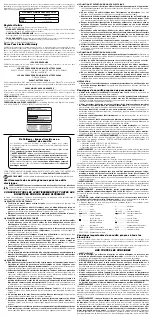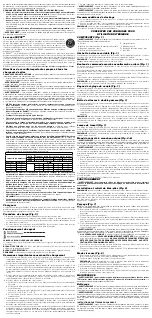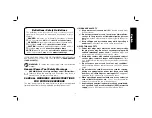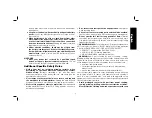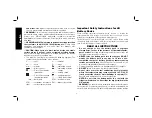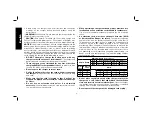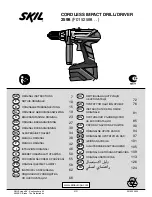
Keyless Single Sleeve Chuck (Fig. 4–6)
WARNING:
Do not attempt to tighten drill bits (or any other accessory) by gripping the front part
of the chuck and turning the tool on. Damage to the chuck and personal injury may result. Always
lock off trigger switch and disconnect tool from power source when changing acces sories.
WARNING:
Always ensure the bit is secure before starting the tool. A loose bit may eject from
tool causing possible personal injury.
Your tool features a keyless chuck (F) with one rotating sleeve for one-handed operation of the
chuck. To insert a drill bit or other accessory, follow these steps.
1. Turn tool off and disconnect tool from power source.
2. Grasp the black sleeve of the chuck with one hand and use the other hand to secure the tool.
Rotate the sleeve counterclockwise far enough to accept the desired accessory.
3. Insert the accessory about 3/4" (19 mm) into the chuck and tighten securely by rotating the
chuck sleeve clockwise with one hand while holding the tool with the other. Your tool is equipped
with an automatic spindle lock mechanism. This allows you to open and close the chuck with
one hand.
Be sure to tighten chuck with one hand on the chuck sleeve and one hand holding the tool for
maximum tightness.
To release the accessory, repeat steps 1 and 2 above.
OPERATION
WARNING: To reduce the risk of serious personal injury, turn tool off and remove the
battery pack before making any adjustments or removing/installing attachments or
accessories.
An accidental start-up can cause injury.
Installing and Removing the Battery Pack (Fig. 2)
NOTE:
For best results, make sure your battery pack is fully charged.
To install the battery pack (H) into the tool handle, align the battery pack with the rails inside the tool’s
handle and slide it into the handle until the battery pack is fi rmly seated in the tool and ensure that
it does not disengage.
To remove the battery pack from the tool, press the release button (G) and fi rmly pull the battery pack
out of the tool handle. Insert it into the charger as described in the charger section of this manual.
Drilling (Fig. 7)
NOTICE:
If drilling thin material, use a wood “back-up” block to prevent damage to the material.
1. Select the desired speed/torque range using the gear shifter to match the speed and torque to
the planned operation. Turn the collar (C) to the drill symbol.
2. Use sharp drill bits only.
3. Always apply pressure in a straight line with the bit. Use enough pressure to keep drill biting, but
do not push hard enough to stall the motor or defl ect the bit.
4. Hold tool fi rmly with both hands to control the twisting action of the drill. If model is not equipped
with side handle, grip drill with one hand on the handle and one hand on the battery pack.
WARNING:
Drill may stall if overloaded causing a sudden twist. Always expect the stall. Grip the
drill fi rmly to control the twisting action and avoid injury.
5.
IF DRILL STALLS
, it is usually because it is being overloaded or improperly used.
RELEASE
TRIGGER IMMEDIATELY
, remove drill bit from work, and determine cause of stalling.
DO
NOT DEPRESS TRIGGER ON AND OFF IN AN ATTEMPT TO START A STALLED DRILL
— THIS CAN DAMAGE THE DRILL.
6. To minimize stalling or breaking through the material, reduce pressure on drill and ease the bit
through the last fractional part of the hole.
7. Keep the motor running when pulling the bit back out of a drilled hole. This will help prevent
jamming.
Screwdriving (Fig. 8)
1. Select the desired speed/torque range using the gear shifter to match the speed and torque to
the planned operation.
2. Turn the torque adjustment collar (C) to the desired position.
NOTE:
Use the lowest torque setting required to seat the fastener at the desired depth. The
lower the number, the lower the torque output.
3. Insert the desired fastener accessory into the chuck as you would any drill bit.
4. Make some practice runs in scrap or on unseen areas of the workpiece to determine the proper
position of the torque adjustment collar.
5. Always start with lower torque settings, then advance to higher torque settings to avoid damage
to the workpiece or fastener.
MAINTENANCE
WARNING: To reduce the risk of serious personal injury, turn tool off and remove the
battery pack before making any adjustments or removing/installing attachments or
accessories.
An accidental start-up can cause injury.
Cleaning
WARNING:
Blow dirt and dust out of all air vents with clean, dry air at least once a week. To
minimize the risk of eye injury, always wear ANSI Z87.1 approved eye protection when performing
this.
WARNING:
Never use solvents or other harsh chemicals for cleaning the non-metallic parts of the
tool. These chemicals may weaken the plastic materials used in these parts. Use a cloth dampened
only with water and mild soap. Never let any liquid get inside the tool; never immerse any part of the
tool into a liquid.
CHARGER CLEANING INSTRUCTIONS
WARNING:
Shock hazard. Disconnect the charger from the AC outlet before cleaning. Dirt and
grease may be removed from the exterior of the charger using a cloth or soft non-metallic brush. Do
not use water or any cleaning solutions.
Repairs
The charger and battery pack are not serviceable.
To assure product SAFETY and RELIABILITY, repairs, maintenance and adjustment (including brush
inspection and replacement) should be performed by a D
E
WALT factory service center, a D
E
WALT
authorized service center or other qualifi ed service personnel. Always use identical replacement
parts.
Accessories
WARNING:
Since accessories, other than those offered by D
E
WALT, have not been tested with
this product, use of such accessories with this tool could be hazardous. To reduce the risk of injury,
only D
E
WALT recommended accessories should be used with this product.
•
These chargers are not intended for any uses other than charging D
E
WALT rechargeable
batteries.
Any other uses may result in risk of fi re, electric shock or electrocution.
•
Do not expose the charger to rain or snow.
•
Pull by the plug rather than the cord when disconnecting the charger.
This will reduce the
risk of damage to the electric plug and cord.
•
Make sure that the cord is located so that it will not be stepped on, tripped over or
otherwise subjected to damage or stress.
•
Do not use an extension cord unless it is absolutely necessary.
Use of improper extension
cord could result in risk of fi re, electric shock or electrocution.
•
When operating a charger outdoors, always provide a dry location and use an extension
cord suitable for outdoor use.
Use of a cord suitable for outdoor use reduces the risk of
electric shock.
•
An extension cord must have adequate wire size (AWG or American Wire Gauge) for
safety.
The smaller the gauge number of the wire, the greater the capacity of the cable, that is,
16 gauge has more capacity than 18 gauge. An undersized cord will cause a drop in line voltage
resulting in loss of power and overheating. When using more than one extension to make up the
total length, be sure each individual extension contains at least the minimum wire size. The following
table shows the correct size to use depending on cord length and nameplate ampere rating. If in
doubt, use the next heavier gauge. The lower the gauge number, the heavier the cord.
Minimum Gauge for Cord Sets
Ampere Rating
Volts
Total Length of Cord in Feet (meters)
120V
25 (7.6)
50 (15.2)
100 (30.5)
150 (45.7)
240V
50 (15.2)
100 (30.5)
200 (61.0)
300 (91.4)
More
Than
Not More
Than
AWG
0
6
18
16
16
14
6
10
18
16
14
12
10
12
16
16
14
12
12
16
14
12
Not Recommended
•
Do not place any object on top of the charger or place the charger on a soft surface
that might block the ventilation slots and result in excessive internal heat.
Place the
charger in a position away from any heat source. The charger is ventilated through slots in the
top and the bottom of the housing.
•
Do not operate the charger with a damaged cord or plug.
•
Do not operate the charger if it has received a sharp blow, been dropped or otherwise
damaged in any way.
Take it to an authorized service center.
•
Do not disassemble the charger; take it to an authorized service center when service or
repair is required.
Incorrect reassembly may result in a risk of electric shock, electrocution or fi re.
•
Disconnect the charger from the outlet before attempting any cleaning. This will
reduce the risk of electric shock.
Removing the battery pack will not reduce this risk.
•
NEVER
attempt to connect 2 chargers together.
•
The charger is designed to operate on standard 120V household electrical power. Do
not attempt to use it on any other voltage.
This does not apply to the vehicular charger.
Chargers
Your tool uses a D
E
WALT charger. Be sure to read all safety instructions before using your charger.
Consult the chart at the end of this manual for compatibility of chargers and battery packs.
Charging Procedure (Fig. 3)
1. Plug the charger into an appropriate outlet before inserting the battery pack.
2. Insert the battery pack (H) into the charger, as shown in Figure 3, making sure the pack is fully
seated in charger. The red (charging) light will blink continuously, indicating that the charging
process has started.
3. The completion of charge will be indicated by the red light remaining ON continuously. The pack
is fully charged and may be used at this time or left in the charger.
Indicator Light Operation
PACK CHARGING
PACK CHARGED
LEAVING THE BATTERY PACK IN THE CHARGER
The charger and battery pack can be left connected with the charge indicator showing Pack
Charged.
WEAK BATTERY PACKS:
Weak batteries will continue to function but should not be expected to
perform as much work.
FAULTY BATTERY PACKS:
This charger will not charge a faulty battery pack.
NOTE:
This could also mean a problem with a charger.
Important Charging Notes
1. Longest life and best performance can be obtained if the battery pack is charged when the air
temperature is between 65 °F and 75 °F (18° – 24 °C). DO NOT charge the battery pack in an
air temperature below +40 °F (+4.5 °C), or above +105 °F (+40.5 °C). This is important and will
prevent serious damage to the battery pack.
2. The charger and battery pack may become warm to the touch while charging. This is a normal
condition, and does not indicate a problem. To facilitate the cooling of the battery pack after use,
avoid placing the charger or battery pack in a warm environment such as in a metal shed or an
uninsulated trailer.
3. A cold battery pack will charge at about half the rate of a warm battery pack. The battery
pack will charge at that slower rate throughout the entire charging cycle and will not return to
maximum charge rate even if the battery pack warms.
4. If the battery pack does not charge properly:
a.
Check operation of receptacle by plugging in a lamp or other appliance;
b.
Check to see if receptacle is connected to a light switch which turns power off when you turn
out the lights;
c.
Move the charger and battery pack to a location where the surrounding air temperature is
approximately 65 °F – 75 °F (18° – 24 °C);
d.
If charging problems persist, take the tool, battery pack and charger to your local service
center.
5. The battery pack should be recharged when it fails to produce suffi cient power on jobs which
were easily done previously. DO NOT CONTINUE to use under these conditions. Follow the
charging procedure. You may also charge a partially used pack whenever you desire with no
adverse effect on the battery pack.
6. Foreign materials of a conductive nature such as, but not limited to, grinding dust, metal chips,
steel wool, aluminum foil, or any buildup of metallic particles should be kept away from charger
cavities. Always unplug the charger from the power supply when there is no battery pack in the
cavity. Unplug the charger before attempting to clean.
7. Do not freeze or immerse the charger in water or any other liquid.
WARNING:
Shock hazard. Don’t allow any liquid to get inside the charger. Electric shock may
result.
WARNING:
Burn hazard. Never attempt to open the battery pack for any reason. If the plastic
housing of the battery pack breaks or cracks, return to a service center for recycling.
Storage Recommendations
1. The best storage place is one that is cool and dry, away from direct sunlight and excess heat or
cold.
2. For long storage, it is recommended to store a fully charged battery pack in a cool dry place out
of the charger for optimal results.
NOTE:
Battery packs should not be stored completely depleted of charge. The battery pack will
need to be recharged before use.
SAVE THESE INSTRUCTIONS FOR FUTURE USE
COMPONENTS (Fig. 1)
WARNING:
Never modify the power tool or any part of it. Damage or personal injury could result.
A. Trigger switch
E. Worklight
B. Forward/reverse control button
F. Keyless chuck
C. Torque adjustment collar
G. Battery release button
D. Gear shifter
H. Battery pack
Variable Speed Trigger Switch (Fig. 1)
To turn the tool on, squeeze the trigger switch (A). To turn the tool off, release the trigger switch.
Your tool is equipped with a brake. The chuck will stop as soon as the trigger switch is fully released.
NOTE:
Continuous use in variable speed range is not recommended. It may damage the switch
and should be avoided.
Forward/Reverse Control Button (Fig. 1)
A forward/reverse control button (B) determines the rotational direction of the tool and also serves
as a lock-off button.
To select forward rotation, release the trigger switch and depress the forward/reverse control
button on the right side of the tool.
To select reverse rotation, depress the forward/reverse control button on the left side of the tool.
The center position of the control button locks the tool in the off position. When changing the
position of the control button, be sure the trigger is released.
NOTE:
The fi rst time the tool is run after changing the direction of rotation, you may hear a click on
start up. This is normal and does not indicate a problem.
Torque Adjustment Collar (Fig. 1)
Your tool has an adjustable torque screwdriver mechanism for driving and removing a wide array of
fastener shapes and sizes. Circling the collar (C) are numbers and a drill bit symbol. These numbers
are used to set the clutch to deliver a torque range. The higher the number on the collar, the higher
the torque and the larger the fastener which can be driven. To select any of the numbers, rotate until
the desired number aligns with the arrow.
Dual Range Gearing (Fig. 1)
The dual range feature of your drill/driver allows you to shift gears for greater versatility.
1. To select speed 1 (high torque setting), turn the tool off and permit it to stop. Slide the gear shifter
(D) forward (towards the chuck).
2. To select speed 2 (low torque setting), turn the tool off and permit it to stop. Slide the gear shifter
back (away from the chuck).
NOTE:
Do not change gears when the tool is running. Always allow the drill to come to a complete
stop before changing gears. If you are having trouble changing gears, make sure that the dual range
gear shifter is either completely pushed forward or completely pushed back.
Worklight (Fig. 1)
There is a worklight (E) located just above the trigger switch (A). The worklight is activated when
the trigger switch is depressed, and will automatically turn off 20 seconds after the trigger switch is
released. If the trigger switch remains depressed, the worklight will remain on.
NOTE:
The worklight is for lighting the immediate work surface and is not intended to be used as
a fl ashlight.
FIG. 7
SCREWDRIVING
VISSAGE
DESTORNILLADO
FIG. 8
DRILLING
PERÇAGE
TALADRADO
C
C
FIG. 3
H
FIG. 2
FIG. 5
FIG. 6
F
FIG. 4
A
B
C
FIG. 1
D
F
E
G
H
H
G
Summary of Contents for DCK240C2
Page 9: ......



